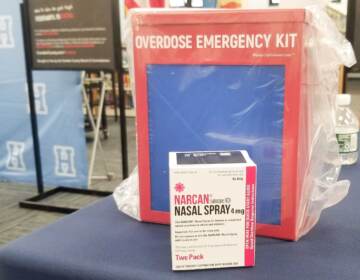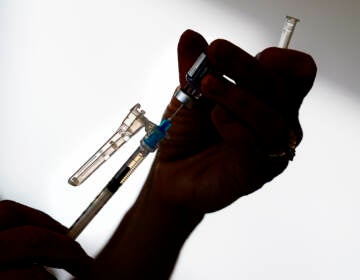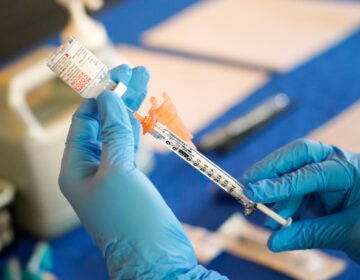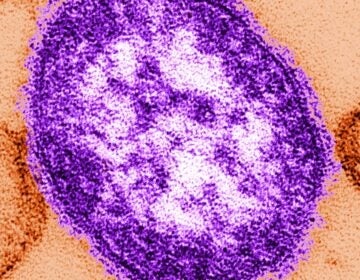Pennsylvania to monitor emerging drugs in the addiction and overdose epidemic
Fentanyl continues to drive overdose deaths in Philadelphia and Pennsylvania. But cases involving xylazine, para-fluorofentanyl, and gabapentin grow.
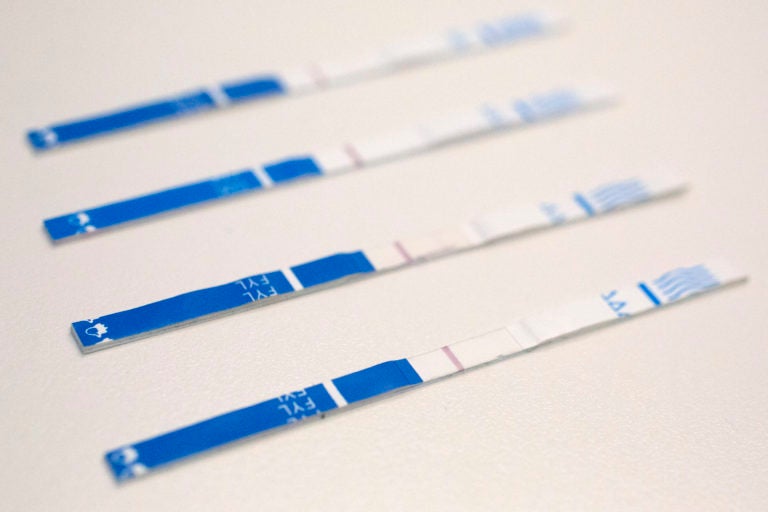
This May 10, 2018 photo shows an arrangement of fentanyl test strips in New York. (AP Photo/Mark Lennihan)
Traditional opioid prescribing and related overdoses across the state are steadily declining, but fentanyl continues to fuel overdose deaths in Philadelphia and across Pennsylvania.
Now, state officials say they’re closely monitoring other drugs that are becoming increasingly prevalent in fatal cases.
“There continues to be a critical need for continued overdose prevention and surveillance efforts,” Dr. Carrie Thomas Goetz, epidemiologist for the state Prescription Drug Monitoring Program, said during a state board meeting Tuesday.
Preliminary state data shows that 3,018 people in Pennsylvania have died from a drug overdose so far this year. According to state officials, numbers are on pace to where they were last year at this time.
The state set a goal to reduce the number of opioid painkillers prescribed at pharmacies and health offices, especially in amounts that could lead to misuse and addiction.
Opioid prescribing in Pennsylvania has fallen about 48% since 2016, said Ashley Bolton, director of the state Office of Drug Surveillance and Misuse Prevention.
However, other substances and misused medications like xylazine, para-fluorofentanyl, and gabapentin are now cropping up in fatal cases more than they ever have before.
Xylazine is a non-opioid animal tranquilizer and sedative. Goetz said it’s been in the street drug supply for several years, but it has now spread.
“It’s reported to enhance the high from opioids, and the effects can persist longer than the opioid. Also, xylazine does not significantly respond to naloxone,” she said, referring to the opioid overdose reversal medication.
Xylazine was detected in one county in 2017 – that grew to 25 counties in 2020, and 37 counties in 2021.
There have been an estimated 247 overdose deaths involving xylazine so far this year, Goetz said.
She added that xylazine is also concerning because it’s been associated with open skin ulcers among people who inject drugs “that may lead to excessive skin breakdown and necrosis with amputation of the extremity noted in particularly severe cases.”
State officials are closely monitoring the emergence of para-fluorofentanyl, an illicit opioid analog that may have a potency similar to, or slightly less than, fentanyl.
The U.S. Centers for Disease Control and Prevention issued a report in late September on the early presence of para-fluorofentanyl nationally. Pennsylvania was one of six states that recorded higher numbers of overdose deaths involving the substance.
There were 229 fatal cases in Pennsylvania from July 2020 to June 2021. They were concentrated in Allegheny, Bucks, Montgomery, Philadelphia, and Washington counties.
“Because data on potency are limited, it’s unclear whether para-fluorofentanyl poses a higher risk than fentanyl does alone,” Goetz said.
State officials say gabapentin-involved overdose deaths have also increased significantly in recent years. Gabapentin is an anticonvulsant medication used to treat seizures and nerve pain. It’s sometimes used as an alternative to opioids for pain management.
Taken alone, overdoses from the medication are rare. But the risk of death rises as the drug is used along with other substances.
Goetz said overdose cases involving all of these drugs are likely underreported.
“Because the illicit drug market continues to evolve rapidly and some jurisdictions may have had a lack of or had limited testing capabilities,” Goetz said, “a critical need does exist for expanded, enhanced toxicology testing to detect para-fluorofentanyl and other emerging drugs.”
If you or someone you know is struggling with substance use, SAMHSA’s National Helpline is a free, confidential, 24-hour hotline that offers referrals to local treatment facilities, support groups, and community-based organizations. Call 1-800-662-HELP for more information.
WHYY is your source for fact-based, in-depth journalism and information. As a nonprofit organization, we rely on financial support from readers like you. Please give today.


